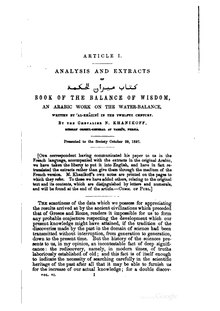al-Khazini
Al-Chazini (internationally also al-Khazini ), actually Abu'l-Fath 'Abd al-Raḥmān al-Chāzinī (أبوالفتح عبدالرحمن منصور الخازنی), was an astronomer of Byzantine descent. He wrote about mechanics and scientific instruments and worked in Merw in the first half of the 12th century .

Also called Abu Mansur or Abd-al-Rahman Mansur in some sources.
life and work
He was a slave and later freedman of Byzantine origin, who was brought to Merw by the treasurer (Chazin, hence his name) of the Seljuk ruler and received a good education there. His master's name was Abu'l Husain 'Alī ibn Muhammad al-Chāzin al-Marwazī.
Al-Chazini is documented from around 1115 to 1131.
His main astronomical work are astronomical tables (al-Zidsch al-Sandschari, German 'astronomical tables for Sandschar'), which were created between around 1118 and 1131. They are dedicated to the Seljuk Sultan Sandjar ibn Malikschah ( Ahmad Sandschar , ruled 1118–1157) and influenced by Thabit ibn Qurra , al-Battani and al-Biruni , but are also based on own observations in Merw. It contains observations of planets, sun and moon (eclipses, conjunctions, etc.), the skewness of the ecliptic, visibility of planets and calendar dates as well as a catalog of stars. Tables for calculating the direction to Mecca (Quibla) seem lost. The manual was known in Byzantium to Georges Chrysocces ( fl. 1335–1346) and Theodore Meliteniotes (fl. 1360–1388).
He also wrote a smaller treatise on a revolving model of the celestial sphere and another on astronomical observation instruments (Risāla fī-l-ālāt). The seven parts deal with the three-rod (triquetrum), dioptra , a triangular (triangular) instrument, a quadrant , devices with light reflection, an astrolabe and simple aids for observation with the naked eye. The quadrant is called "suds" (sextant), although it covered a full ninety degree angle, not just sixty degrees. For the instruments, the geometric basis is also dealt with.
His most important work is his "Book of the Balance of Wisdom" (Kitāb mīzān al-hikma) from 1121/22, a treatise on statics and hydrostatics. It describes a very precise hydrostatic balance with which one can distinguish false from real gemstones and metals via the specific weight (according to the principle known from Archimedes ) and was dedicated to Sultan Sandjab. In some cases the balance achieved accuracies in the range of one percent. His predecessor al-Asfizari had also built such scales (they were called mizan al-hikma ). The extensive book (8 books with 80 chapters) shows the sources for mechanics of the time: From antiquity Aristotle and Pseudo-Aristotle, Euclid , Archimedes, Menelaus ; from the Islamic culture of Rhazes , Alhazen , al-Biruni, Omar Chayyām , Abu Sahl al-Quhi .
Fonts
Editions of the Book of the Balance of Wisdom:
- Extracts in Arabic and English translation from N. Khanikoff: Journal of the American Oriental Society. Volume 6. New Haven 1860, pp. 1–128 ( Textarchiv - Internet Archive ).
- Kitab mizan al-hikma. Hyderabad 1940/41.
- Mizan al-hikma. Ed .: Fuad Jamian. Cairo 1947 (incomplete).
literature
- Julio Samsò: Al-Khāzinī. In: Helaine Selin (Ed.): Encyclopaedia of the History of Science, Technologie, and Medecine in Non-Western Cultures. Springer-Verlag, 2008, pp. 135-136.
- Robert E. Hall: Al-Khāzinī, Abu'l-Fath 'Abd Al-Raḥmān. In: Dictionary of Scientific Biography . Volume 7, pp. 335-351.
Individual evidence
- ^ Description from Hall: Dictionary of Scientific Biography. Volume 7, p. 338.
| personal data | |
|---|---|
| SURNAME | Chazini, al- |
| ALTERNATIVE NAMES | Chāzinī, Abu'l-Fath 'Abd al-Raḥmān al-; Abu Mansur; Khazini, Al- |
| BRIEF DESCRIPTION | Astronomer of the Islamic Middle Ages |
| DATE OF BIRTH | 11th century or 12th century |
| DATE OF DEATH | 12th Century |